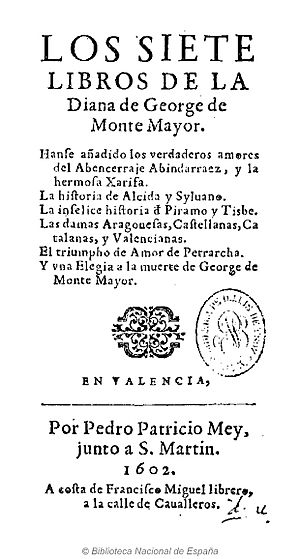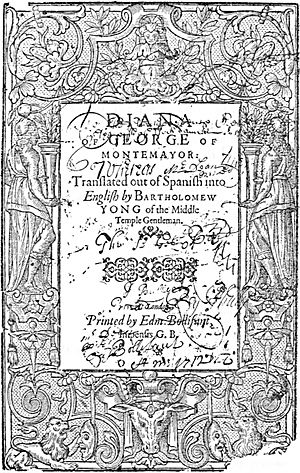Diana (pastoral romance) facts for kids
The Seven Books of the Diana (Spanish: Los siete libros de la Diana) is a famous story from the 1500s. It was written by a Portuguese author named Jorge de Montemayor. This book is a pastoral romance, which means it's a story about shepherds, shepherdesses, and their adventures in love.
The Diana was first published in 1559. It quickly became a bestseller and made stories about country life and love very popular. Even famous writers like William Shakespeare read it. He might have used ideas from the Diana for his play The Two Gentlemen of Verona.
Contents
The Story of Diana
The story starts with a shepherd named Sireno. He is in love with a shepherdess named Diana. They once loved each other very much. But Sireno had to leave their village for a year. While he was away, Diana married another shepherd named Delio.
Love and Magic in the Countryside
When Sireno returns, he already knows Diana is married. As the story unfolds, Sireno meets other shepherds and shepherdesses. They all share their own sad love stories. One character is a brave warrior maiden named Felismena. She helps Sireno and his friends escape from wild men.
The group decides to visit a powerful enchantress named Felicia. They hope she can help them with their love problems. Felicia welcomes them to her amazing castle. Inside, they see wonderful sights, including halls dedicated to Venus and Mars. They even watch a performance by the legendary Orpheus.
Felicia's Magic Potion
After they rest, Felicia gives them a special magic potion. This potion changes their old feelings. For example, Sireno is cured of his love for Diana. He no longer feels sad about her marriage.
In the later parts of the book, many love stories are solved. Some shepherds find new partners. Others get back the ones they thought they had lost. Felismena finds her lover, Don Felis. She saves him from enemy knights. With Felicia's magic, Felis remembers his love for Felismena, and they get married.
However, Sireno and Diana's story doesn't fully resolve. Sireno can now see Diana without feeling anything. But Diana is clearly upset by his change. She regrets being forced to marry someone else. The book ends by promising a sequel, but Montemayor never wrote one.
How the Book Grew and Inspired Others
The Diana became so popular that new parts were added to it.
New Stories and Editions
In 1561, a new version of the book was printed. It included a new story called the "Abencerraje." This tale was added to entertain the shepherds in Felismena's palace. Experts believe Montemayor himself wrote this new material.
Other Writers Continue the Story
Montemayor's book inspired two other writers to create their own sequels in Spanish. Both were published in 1564:
- Alonso Pérez wrote La Segunda Parte de la Diana (The Second Part of the Diana).
- Gaspar Gil Polo wrote Diana Enamorada (Enamoured Diana).
When the Diana was translated into English by Bartholomew Yong in 1598, it included both of these sequels.
Diana's Popularity and Influence
The Diana was one of the most popular books of its time. It was loved not just in Spain, but also in other countries.
A Bestseller Across Europe
Many copies of the Diana were printed. In the 1500s alone, there were at least 31 Spanish editions. There were also 12 French translations and one English translation by Bartholomew Yong. This shows how widely read the book was.
Influencing Famous Playwrights
The story of Felismena in the Diana likely inspired William Shakespeare. In her story, Felismena dresses as a boy to follow her lover. Shakespeare used a similar idea in his play The Two Gentlemen of Verona. The Diana also explored themes of love, strong female characters, and tricky romantic situations. These ideas were very important for Shakespeare's comedies.
Inspiring Other Writers
The Diana also greatly influenced Philip Sidney when he wrote his famous book, the New Arcadia. Sidney's friends even noticed the connection. One friend, John Hoskins, said that Sidney used ideas from the Diana for his story.
Mentioned in Don Quixote
Even Miguel de Cervantes, the author of Don Quixote, mentioned the Diana. In his book, a priest is deciding which books to burn. He says the Diana is too good to be destroyed. He praises its prose but suggests removing some parts, like the magic and long poems.
English Translations
Diana has been translated into English two times:
- The first translation was by Bartholomew Yong in 1598.
- A more recent translation was done by RoseAnna M. Mueller in 1989.
See also
 In Spanish: Los siete libros de la Diana para niños
In Spanish: Los siete libros de la Diana para niños



